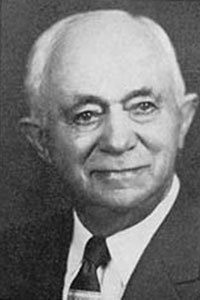
Eminent Farmer
County: Day
Henry F. Hansmeier, born in Lippe, Germany, in 1874, came to America at the age of 20. He first worked in Waukon, Iowa, eight months, and saved every cent of his $120 salary, before going to Forest City, Iowa, where he bought his first farm with his brother. After that he farmed in Pipestone County, Minnesota, and from there came to Day County.
In 1896, Hansmeier was married to Helen Helming.
All through his life, Hansmeier’s desire to improve existing conditions, has led to benefits not only for himself, but also for others.
In 1911, for example, he started work on a crop that was to be one of the biggest factors leading to his business success—alfalfa. That year he planted 13 acres of registered Grimm alfalfa. This 13 acres produced breeding stock for most of the existing alfalfa fields in Day County as well as in other parts of South Dakota. Coteau Hills brand alfalfa seed, which he started developing about the same time, is now used by the company, and is widely known.
His becoming a Kentucky bluegrass and millet magnate is another example. His company now owns 225 strippers which are loaned to farmers to strip the seed of bluegrass.
In addition to direct benefits to South Dakota Agricultural economy, Hansmeier has been a benefactor of many other causes. These include helping his brother buy a farm in war-torn Germany, to furnishing a recreation center and library for Bristol and from contributing all proceeds from his 170—page hard-bound autobiography, “This is My Life,” to needy Asian children, to giving ample donations to the Wesley Methodist Student Foundation at South Dakota State College, where he has been made a Life Member. Other favorite charities are Father Flanagan’s Boys Town and Dakota Wesleyan University.
Other contributions have included serving as a member of the South Dakota House of Representatives in 1928, providing seed for European gardens after the war and share-farming with Bristol agricultural students. He was named “Outstanding South Dakota Agriculturalist” in 1956 by the South Dakota State College Agricultural Education Club.

